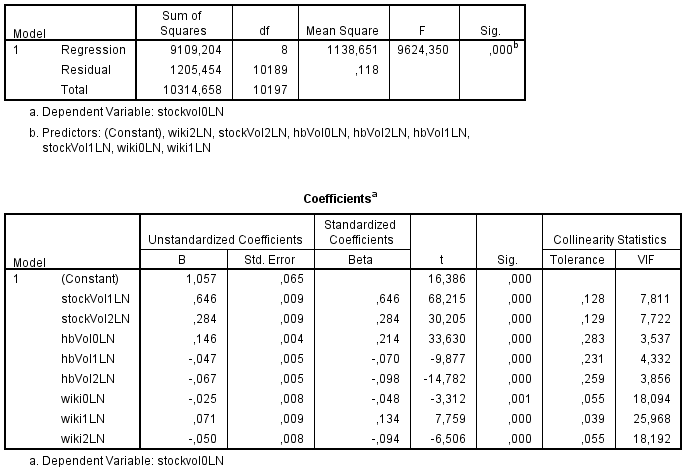For 86 companies and for 103 days, I have collected (i) tweets (variable hbVol0) about each company and (ii) pageviews for the corporate wikipedia page (wikiVol0). The dependent variable is each company's stock trading volume (stockVol0). My data is structured as follows:
company date hbVol0 wikiVol0 stockVol0 comp1 comp2 ... comp86 marketRet
-------------------------------------------------------------------------------
1 1 200 150 2423325 1 0 ... 0 -2.50
1 2 194 152 2455343 1 0 ... 0 -1.45
. . . . . . . ... .
1 103 205 103 2563463 1 0 ... 0 1.90
2 1 752 932 7434124 0 1 ... 0 -2.50
2 2 932 823 7464354 0 1 ... 0 -1.45
. . . . . . . ... .
. . . . . . . ... .
86 103 3 55 32324 0 0 ... 1 1.90
As you can see, the dataset is a pooled cross-sectional time series data. Although other models would be better suited, my thesis coach was OK with me running an OLSon it. After taking the log for stockVol0 and wikiVol0 and taking lag 1 and 2 for all variables, this is one of the best-fitting regressions:

Now, my coach tells me "to do some predictive modelling". Since we have had very little statistics classes, I am unfamiliar with this. My coach told me "to do an easy random forest model", but SPSS (which is the only software I have and am somewhat used to) doesn't have a "random forest" model in it's options. It does support ARIMA, an I have been told it can do forecasting as well. So I tried, but SPSS interprets all (103 x 86) 8,858 rows in the dataset as being unique dates. But there are only 103 days (see date variable in dataset).
Question 1: can anybody tell me how to tell SPSS I have 86 observations for each of the 103 days and not 8,858 dates?
Question 2: am I right that ARIMA is a forecasting model? If not, what is a basic forecasting model that I could apply and/or is random forest available in SPSS under a different name?
P.S. I have asked around among my friends, and 90% of my fellow student graduate without having any predictive modeling in their thesis. It's just that my coach really wants it in there, so a basic model will suffice. I hope some people here can help me on my way since my thesis is due in 2 weeks and I am totally lost here...
